The Dark Chanting Goshawk (Melierax metabates) commands attention with its powerful presence and distinctive characteristics.
Endemic to the African continent and parts of the Arabian Peninsula, this raptor belongs to the Accipitridae family, showcasing remarkable adaptability across diverse habitats.
Recognized by its slate-gray to dark charcoal plumage, accentuated by a contrasting cap on its head, the Dark Chanting Goshawk is renowned for its melodious and rhythmic vocalizations, earning it its evocative name.
With a wingspan of 100 to 120 centimeters, it is an agile flier, utilizing short and rounded wings for efficient flight.
This bird of prey is a skilled hunter, preying on small mammals, birds, and insects, and its breeding behaviors, nesting habits, and geographic subspecies variations further contribute to the intricate tapestry of its captivating existence in the wild.
The Dark Chanting Goshawk stands as a symbol of avian prowess and adaptability, embodying the essence of Africa’s diverse ecosystems. Stay focused.
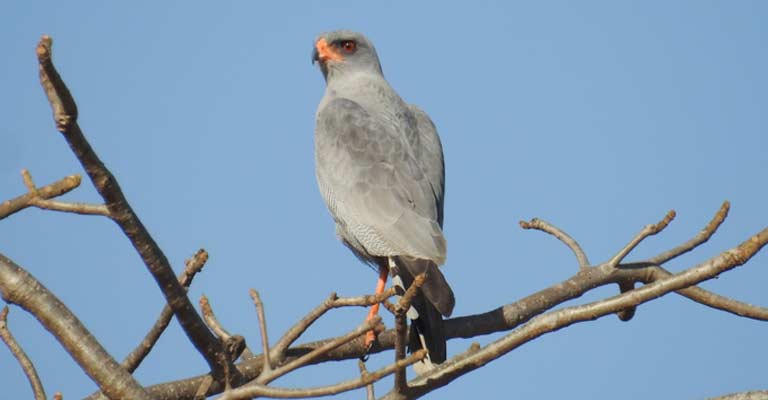
Identifying Characteristics of Dark Chanting Goshawk
The Dark Chanting Goshawk (Melierax metabates) is a striking bird of prey native to the African continent. Identifying this species requires a keen eye and an understanding of its distinctive characteristics.
Here are some key points to help identify the Dark Chanting Goshawk:
Size and Shape
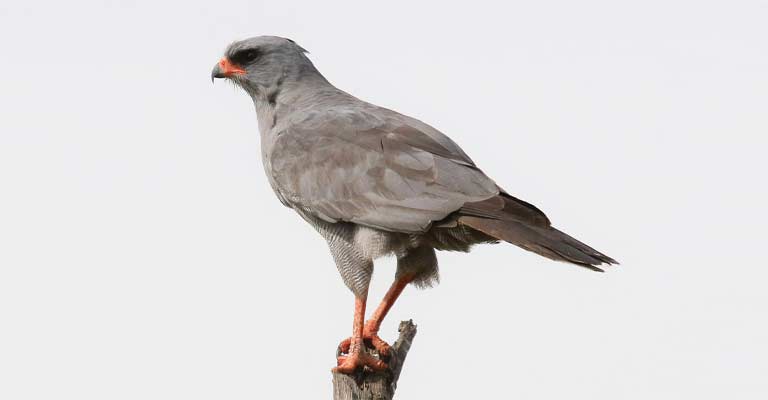
The Dark Chanting Goshawk is a medium-sized raptor with a length ranging from 45 to 60 centimeters (18 to 24 inches).
It has a robust build and a broad wingspan of about 100 to 120 centimeters (40 to 48 inches). The bird’s wings are relatively short and rounded, emphasizing its agility during flight.
Coloration
One of the most noticeable features of the Dark Chanting Goshawk is its striking coloration.
Adults typically have a slate-gray to dark charcoal plumage on their upperparts, while the underparts are lighter, ranging from pale gray to white. Juveniles may have a more mottled appearance with brown streaks.
Head and Facial Features
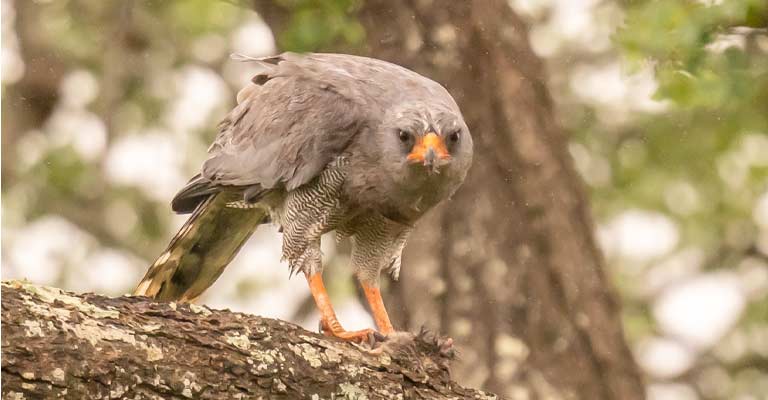
The bird’s head is characterized by a dark cap, contrasting with a white or pale gray face. The eyes are usually dark, and the hooked beak is black and strongly curved, reflecting its predatory nature.
These facial features contribute to the overall intense and focused expression of the Dark Chanting Goshawk.
Tail Pattern
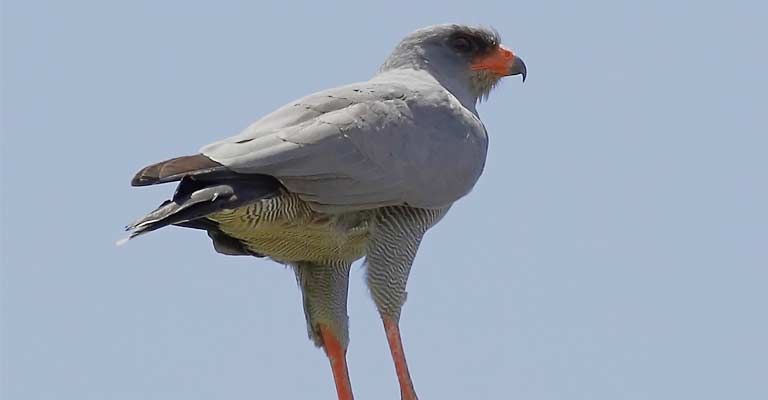
The tail of this goshawk is banded with broad, dark bars. These distinctive tail markings are visible during flight and can aid in quick identification.
The contrasting bands on the tail feathers help differentiate the Dark Chanting Goshawk from other raptors in its range.
Habitat Preference
Understanding the bird’s habitat preference is crucial for identification. Dark Chanting Goshawks are commonly found in savannas, open woodlands, and grasslands.
They prefer areas with scattered trees or bushes, allowing them to use perches for hunting and surveying their surroundings.
Flight Style
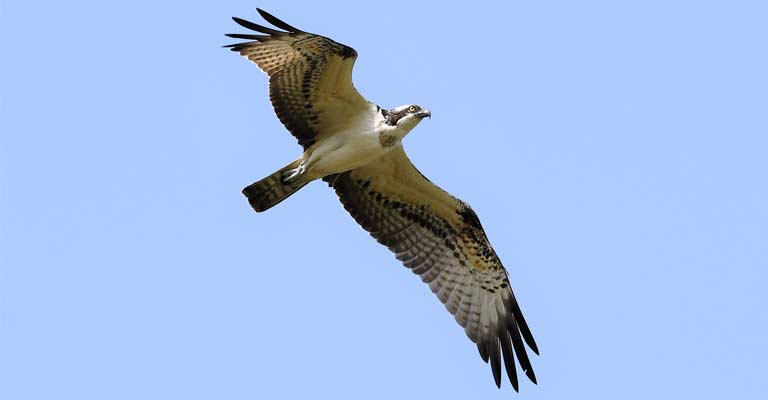
The Dark Chanting Goshawk exhibits a powerful and direct flight style. When in flight, observers can note the short, rounded wings and a distinctive flapping pattern.
The bird often soars with ease and may use updrafts to gain altitude.
Vocalizations
As the name suggests, this goshawk is known for its melodious and rhythmic vocalizations. Its call is often described as a series of clear, whistling notes, resembling a chant.
Familiarizing oneself with these vocalizations can be instrumental in confirming the presence of the Dark Chanting Goshawk in an area.
Behavioral Traits
Observing the bird’s behavior can provide additional clues for identification. Dark Chanting Goshawks are skilled hunters, preying on small mammals, birds, and insects.
They are often seen perched on elevated vantage points, scanning the surroundings for potential prey.
Recognizing the Dark Chanting Goshawk involves a comprehensive assessment of its size, coloration, facial features, tail pattern, habitat, flight style, vocalizations, and behavioral traits.
Combining these elements will enable bird enthusiasts and naturalists to confidently identify this captivating raptor in its African habitat.
Taxonomy of Dark Chanting Goshawk
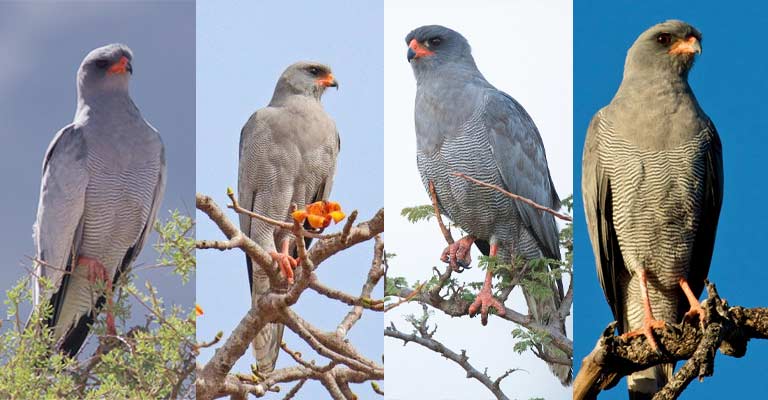
Here is a table outlining the taxonomical details of the Dark Chanting Goshawk:
| Taxonomic Level | Classification |
| Domain | Eukaryota |
| Kingdom | Animalia |
| Phylum | Chordata |
| Class | Aves |
| Order | Accipitriformes |
| Family | Accipitridae |
| Genus | Melierax |
| Species | M. metabates |
The Dark Chanting Goshawk (Melierax metabates) encompasses a diverse range of subspecies, each with its distinct geographic distribution.
- Melierax metabates metabates: Found from Senegal and the Gambia, extending eastward to Ethiopia, and southward to the Democratic Republic of the Congo and northern Tanzania. This subspecies thrives in a variety of habitats, showcasing the adaptability of the Dark Chanting Goshawk.
- Melierax metabates neumanni: Inhabiting regions from Mali to northern Sudan, Melierax meta bates neumanni demonstrates the species’ presence in the arid landscapes of North Africa.
- Melierax metabates theresae: Confined to southwest Morocco, Melierax metabates theresae represents a unique population adapted to the specific environmental conditions of this region.
- Melierax metabates ignoscens: Thriving in the southwestern Arabian Peninsula, including southwestern Saudi Arabia and western Yemen, Melierax metabates ignoscens showcases the bird’s ability to occupy diverse and often challenging terrains.
- Melierax metabates mechowi: Extending from southeastern Gabon to Angola, and southward to northern Namibia and northeastern South Africa, Melierax metabates mechowi spans a wide portion of southern Africa, revealing the species’ adaptability to both forested and savannah environments.
The existence of these subspecies highlights the Dark Chanting Goshawk’s ability to thrive across various landscapes, from arid deserts to lush forests, showcasing the bird’s adaptability and resilience in diverse habitats across the African continent and parts of the Arabian Peninsula.
Studying these subspecies provides valuable insights into the broader ecological context of this magnificent raptor.
Dark Chanting Goshawk Life History
The Dark Chanting Goshawk (Melierax metabates) stands as a charismatic raptor within the African avian community, boasting a fascinating life history shaped by its behaviors, adaptations, and interactions with its environment.
Delving into various aspects of its life cycle provides a deeper understanding of this bird’s ecology and the challenges it faces.
Here, we explore its food preferences, habitat choices, range map, breeding habits, susceptibility to diseases, available treatments, and conservation efforts aimed at safeguarding its population.
Food
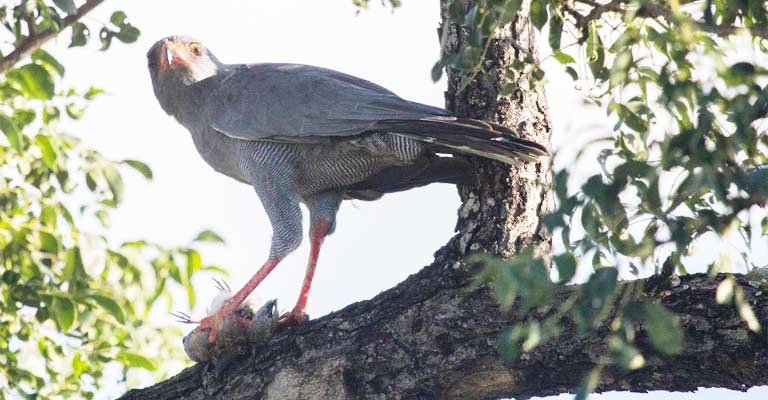
Dark Chanting Goshawks are formidable predators with a diverse diet. Their primary food sources include small mammals, birds, and insects.
With keen eyesight and powerful flight capabilities, they hunt by soaring over open landscapes, using their sharp talons to grasp prey with precision.
The adaptability of their diet allows them to thrive in different ecosystems, from savannas to grasslands, where they can find an abundance of potential prey.
Habitat
The Dark Chanting Goshawk displays a versatile habitat selection, commonly found in open woodlands, savannas, and grasslands.
They prefer areas with scattered trees or bushes that serve as perches for hunting and surveying their surroundings.
This adaptability to various landscapes contributes to their widespread distribution across the African continent.
Range Map
The species has a broad range across sub-Saharan Africa, extending from Senegal in the west to Ethiopia in the east and southwards to South Africa.
A detailed range map outlines their distribution, indicating their presence in diverse ecosystems. This distribution, however, is subject to changes influenced by factors such as habitat degradation and climate variations.
Breeding
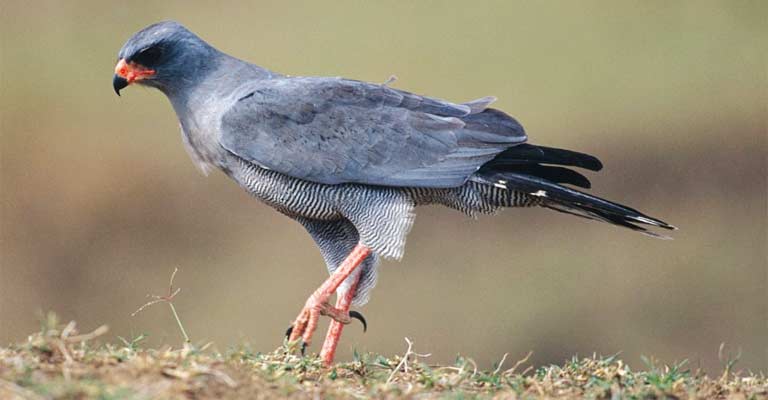
Dark Chanting Goshawks exhibit a monogamous breeding behavior. Breeding pairs establish territories and construct nests in elevated locations, such as trees or cliffs.
The female typically lays two to three eggs, and both parents contribute to incubation and care for the chicks. The young goshawks fledge after a few weeks, marking the successful completion of the breeding season.
Diseases
While the Dark Chanting Goshawk generally displays resilience to diseases, they may be susceptible to avian-related illnesses. Common threats include parasites, bacterial infections, and viral diseases.
Monitoring their health is crucial, especially in regions where anthropogenic factors may introduce new risks.
Treatment
Conservationists and wildlife experts emphasize the importance of comprehensive veterinary care for captive and endangered populations.
Regular health assessments, vaccination programs, and appropriate treatment protocols help mitigate the impact of diseases.
In the wild, maintaining the integrity of their natural habitats remains a critical aspect of disease prevention.
Conservation
The Dark Chanting Goshawk, while not currently considered globally threatened, faces localized threats due to habitat loss, human disturbance, and potential persecution.
Conservation efforts focus on preserving their habitats, implementing sustainable land-use practices, and raising awareness about the importance of these raptors in maintaining ecological balance.
Engaging local communities in conservation initiatives is key to ensuring the long-term survival of the species.
The life history of the Dark Chanting Goshawk is a testament to its adaptability and resilience in the dynamic African landscape.
Understanding the intricacies of its food habits, habitat preferences, breeding behaviors, susceptibility to diseases, available treatments, and conservation needs is essential for fostering a harmonious coexistence between this majestic bird of prey and its environment.
Nesting Habit of Dark Chanting Goshawk
Below is a table detailing the nesting habits of the Dark Chanting Goshawk (Melierax metabates):
| Nesting Detail | Information |
| Clutch Size | 2 to 3 eggs |
| Number of Broods | Typically 1 brood per breeding season |
| Egg Length | Approximately 5 cm (2 inches) |
| Egg Width | Approximately 3.5 cm (1.4 inches) |
| Incubation Period | Around 35 days |
| Nestling Period | Approximately 6 to 7 weeks |
| Egg Description | Pale bluish-white with irregular brown markings |
| Nest Type | Built on elevated sites like trees or cliffs |
| Nest Construction | Constructed with sticks and lined with softer material |
| Nest Placement | Placed in the fork of a tree or on a cliff ledge |
| Parental Involvement | Both parents contribute to incubation and chick care |
| Fledgling Independence | Young goshawks fledge and become independent |
Understanding these nesting details provides valuable insights into the reproductive biology and parental care strategies of the Dark Chanting Goshawk.
The species’ nesting behavior is adapted to its environment, contributing to its successful reproduction and the continuation of its population in the wild.
The Dark Chanting Goshawk exhibits meticulous nesting habits, constructing nests on elevated sites such as trees or cliffs.
Using a combination of sticks and twigs, the goshawks create sturdy platforms lined with softer materials.
Typically laying 2 to 3 pale bluish-white eggs marked with irregular brown patterns, the incubation period spans around 35 days.
Both parents actively participate in incubation and subsequent chick care. Once hatched, the nestlings undergo a developmental period of approximately 6 to 7 weeks before fledging.
This nesting behavior showcases the species’ adaptability to diverse environments, contributing to the successful reproduction and survival of the Dark Chanting Goshawk.
10 Fun Facts About Dark Chanting Goshawk
The Dark Chanting Goshawk (Melierax metabates) is a captivating bird of prey with several intriguing characteristics. Here are 10 fun facts about this remarkable species:
- Melodious Vocalizations: True to its name, the Dark Chanting Goshawk is known for its distinctive and melodious vocalizations. The bird produces a series of clear, whistling notes that resemble a rhythmic chant, making it easily recognizable in its habitat.
- Impressive Hunting Skills: Equipped with keen eyesight and agility, the goshawk is a skilled hunter. It preys on a variety of small mammals, birds, and insects, often hunting from elevated perches and employing a powerful and direct flight to capture its prey.
- Monogamous Breeding Pairs: Dark Chanting Goshawks exhibit monogamous breeding behavior. Breeding pairs form strong bonds and work together to incubate eggs and care for the nestlings, showcasing a cooperative approach to raising their offspring.
- Wide Range Across Africa: These goshawks have a broad distribution across sub-Saharan Africa, ranging from Senegal in the west to Ethiopia in the east and extending southwards to South Africa. Their adaptability to various habitats contributes to their expansive geographic range.
- Distinctive Plumage: Adults feature a striking contrast in plumage, with slate-gray to dark charcoal upperparts and lighter, pale gray to white underparts. This coloration, coupled with a dark cap on the head, contributes to their visually appealing appearance.
- Adaptable Habitat Choices: Dark Chanting Goshawks display adaptability in their habitat choices, thriving in open woodlands, savannas, and grasslands. They favor areas with scattered trees for perching and hunting, demonstrating their ability to exploit diverse environments.
- Rapid Nest Construction: During the breeding season, these goshawks construct nests using sticks and twigs, lined with softer materials for comfort. The speed at which they build these nests reflects their efficiency in preparing a suitable environment for breeding.
- Skilled Fliers: Dark Chanting Goshawks are agile fliers, using short and rounded wings for powerful and controlled flight. They are capable of soaring with ease and may utilize updrafts to gain altitude, showcasing their mastery of the skies.
- Preferential Nesting Sites: The species prefers nesting in elevated locations such as trees or cliffs. This strategic placement helps protect the nest from ground predators and offers an advantageous vantage point for hunting and monitoring the surroundings.
- Conservation Concerns: While not globally threatened, localized threats such as habitat loss and human disturbances pose challenges to Dark Chanting Goshawk populations. Conservation efforts are crucial to ensure the continued survival of this species and its vital role in maintaining ecological balance.
The Dark Chanting Goshawk is a fascinating bird with a combination of unique features, behaviors, and adaptations that contribute to its success in the African landscape.
Wrapping Up
The Dark Chanting Goshawk emerges as a captivating species, adorned with striking plumage, melodious calls, and remarkable adaptability.
Its versatile hunting techniques, monogamous breeding habits, and preference for elevated nesting sites underscore its significance in the African ecosystem.
However, as conservation concerns loom, understanding and appreciating the nuances of its life history become imperative.
By delving into its nesting behaviors, feeding habits, and the challenges it faces, we unveil a story of resilience and interconnectedness with the environment.
As stewards of our planet, it is our responsibility to ensure the continued existence of this magnificent bird, preserving not only a species but a vital thread in the intricate tapestry of biodiversity. Stay focused.